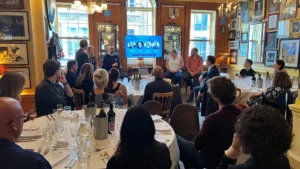We’re speaking to you on the Crowe Advisory yacht, just after you’ve been speaking on the fascinating Numatec panel on AI. What’s your view on how advertising is improving through AI?
It’s the utility opportunity. The opportunity that we move past the concept of advertising as something that consumers skip through, to something that is serving them utility. It’s creating an opportunity for brands to engage with what consumers are interested in. That’s where I’m most excited, alongside the combination of data and creative.
Many creative agencies are still slightly scared of the multiple iteration aspect of AI. Is it really so easy?
It’s exciting as a creative to have the opportunity to create thousands of images from what you’ve done in the past, either to understand your voice better or to get an understanding of how your creative deploys at scale. I get excited by building pipelines and systems than can be changed over time, and based on datasets. A sort of ‘madlibs’ approach. We’re currently running a system called synthetic production that allows us to build forward pipelines of individual assets – a bit like a car configurator – but running it end-to-end using the creative. So, replacing backgrounds, changing the lighting, changing the way the product interacts, all based on the datasets the consumer is providing, serving consumers directly where they are.
What impact will AI have on creativity overall?
I like the idea of being able to scale my creativity and be empowered. I may not be the greatest visual artist but now I am and I can express myself in new and different ways. There’s also an accessibility angle. People who aren’t able to draw or engage with text have opportunities to be creative. AI is breaking up the creative bias.
Where are we on the so-called hype cycle and is this a good or bad thing?
I firmly believe we’re at the beginning, just based on the availability of processing. If you use any of the tools, you notice the delay. Responses aren’t instantaneous. To improve that we’re going to need to scale and improve our computing power massively. There are companies working towards that but it’s a physical thing, requiring minerals and new technical tools. We’re going to hit an expectation gap, but I don’t think the trough of disillusionment will be quite as deep.
Where this will be most valuable is large scale enterprises where they’re not necessarily concerned as much about delays. And, as we get better, the hype cycle corrects itself. Generative AI has been around for a long time but this new version, where it’s become really, really good could be a signal that we’re now out of the trough of disillusionment and we’re on the way up. But, there could be a plateau coming soon, simply because of its physical restrictions. AI is a real tool, it has use, but the trick is how you use it that determines how it plays on the hype cycle.





